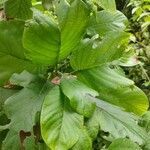A tree. It grows 18 m tall. The trunk is 15 cm across. The branches are densely hairy. The leaves are alternate. They are broadly oval and 8-20 cm long by 4-12 cm wide. They are hairy underneath. There are 4-6 flowers in a group. The fruit are oval and 7 mm long by 5 mm wide and in a shallow tube.


